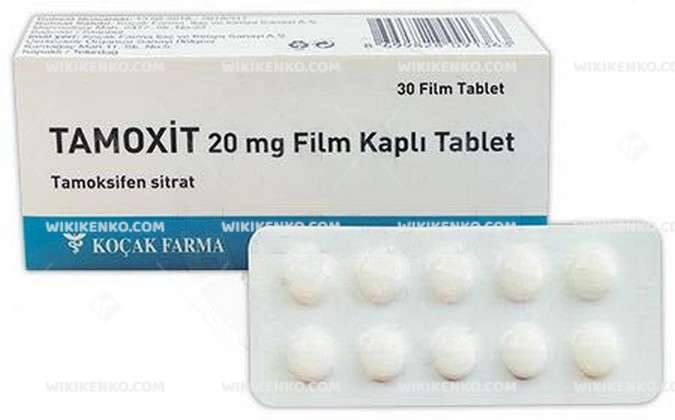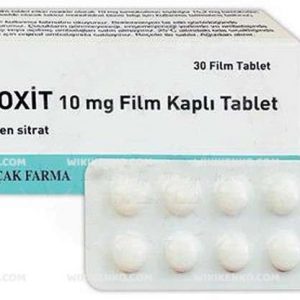Tamoxit Film Coated Tablet 20 Mg
In this comprehensive guide, we delve into the world of Tamoxit Tablet 20 mg, a medication widely used in the treatment and prevention of breast cancer. From its dosage and administration to side effects and precautions, this article offers valuable insights for those seeking information on this critical drug.
| Dosage form | |
|---|---|
| Pack size | |
| Potency | 20 Mg |
| Manufacturer | |
| Origin | |
| Generic Name (Ingredient) | Each Tablet Contains 30.4 Mg Tamoxifen Citrate Equivalent To 20 Mg Tamoxifen. |
Assuming your emergency circumstances for this product, visit Urgent Quotation page. Besides, for any pharmaceutical questions, please ask us in the comments section.
Description
Tamoxit Tablet 20 mg, a powerful tool in the fight against breast cancer, is primarily composed of Tamoxifen. Operating as a Selective Estrogen Receptor Modulator (SERM), it exerts its therapeutic effects by inhibiting the growth of breast cancer cells through the blocking of estrogen receptors.
Precautions and Consultation
If you are considering Tamoxit Tablet 20 mg for reducing the risk of breast cancer or if your cancer is limited to the milk ducts (ductal carcinoma in situ – DCIS), it is imperative to engage in a comprehensive discussion with your healthcare provider. For individuals with breast cancer that has spread to other parts of the body, the initiation of tamoxifen may lead to increased bone/cancer pain and/or disease flare-up.
Tamoxit Availability
Tamoxit Tablet 20 mg is readily available in packs containing 30 film-coated tablets. However, specific availability may vary based on regional regulations and healthcare provisions.
Mechanism of Action
Tamoxit Tablet 20 mg’s active ingredient, Tamoxifen, exerts its therapeutic prowess by blocking the effects of estrogen on hormone receptor-positive breast cancer cells. It accomplishes this by binding to estrogen receptors on the cells, preventing estrogen from attaching and thus impeding the signals that encourage cancer cell growth and proliferation. Tamoxifen’s classification as a Selective Estrogen Receptor Modulator (SERM) underscores its ability to reduce estrogen’s effects throughout the body, including in the breast.
Onset of Action and Duration
Tamoxit Tablet 20 mg initiates its action immediately after oral administration, but its effects remain active for up to two weeks after the last dose. Peak plasma concentration is typically reached around 5 hours post-dosing. Tamoxifen’s elimination from the body is biphasic, with a terminal elimination half-life of about 5 to 7 days. It can take approximately three months for Tamoxifen to be completely eliminated from the system. This medication is often prescribed for long-term treatment, with optimal effectiveness observed when used for 5 years.
Recommended Dosage
The recommended dosage of Tamoxit Tablet 20 mg varies based on the specific medical condition being treated:
- Metastatic breast cancer in women and men: Usual adult dose is 20 to 40 mg orally daily for 5 years, with doses exceeding 20 mg administered in divided doses (morning and evening).
- Ductal Carcinoma in Situ (DCIS) following breast surgery and radiation: Recommended dose is 20 mg orally daily for 5 years.
- Breast Cancer – Adjuvant: Typical adult dose is 20 mg orally once daily or 10 mg orally twice daily, with treatment duration extending up to 5 years.
- McCune-Albright Syndrome; precocious puberty in girls aged 2 to 10 years: Standard pediatric dose is 20 mg orally once daily, with therapy spanning up to 12 months.
To maximize the benefits of Tamoxit Tablet 20 mg, it’s advisable to take it at the same time daily. If a dose is missed, there is no need to double up the next day. In the case of doses exceeding 20 mg per day, dividing the dosage between morning and evening is recommended.
Side Effects Demystified
Tamoxit Tablet 20 mg, powered by Tamoxifen, can induce a range of side effects, both common and serious. Here’s an overview:
Common Side Effects
- Hot Flashes: A frequent occurrence, often accompanied by sensations of warmth and sweating.
- Vaginal Discharge: Many users may experience increased vaginal discharge.
- Fluid Retention (Swelling): Some individuals may notice mild fluid retention, resulting in swelling.
- Weight Loss: Weight loss can be a common side effect.
- Mood Changes: Users may undergo mood swings.
- Skin Rash: Skin rashes can develop in some cases.
- Nausea: Nausea is a possible side effect.
- Joint Pain: Joint pain may occur.
Serious Side Effects
It’s crucial to promptly inform your healthcare provider if any of the following serious side effects manifest:
- Vision Changes: Any alterations in vision.
- Eye Pain: Persistent eye pain.
- Easy Bruising/Bleeding: Unusual bruising or bleeding.
- Mental/Mood Changes: Drastic shifts in mental state.
- Swelling of Ankles/Feet: Sudden swelling of the ankles or feet.
- Unusual Tiredness: Excessive fatigue.
- Signs of Infection: Indications of an infection.
- Signs of Liver Disease: Symptoms suggesting liver issues.
While a severe allergic reaction to Tamoxit Tablet 20 mg is rare, immediate medical attention should be sought if symptoms such as rash, itching/swelling, severe dizziness, or difficulty breathing are experienced.
Breast Cancer
Breast cancer is a formidable disease characterized by the uncontrolled growth of cells within the breast. Various types of breast cancer exist, typically determined by which cells in the breast undergo malignant transformation. In most cases, breast cancer originates in the ducts or lobules of the breast.
- Invasive Ductal Carcinoma: This form involves cancer cells originating in the ducts and subsequently infiltrating adjacent breast tissues. Invasive cancer cells can also metastasize to other parts of the body.
- Invasive Lobular Carcinoma: Cancer cells in this subtype begin in the lobules and may spread to nearby breast tissues. Metastasis to other body parts is also possible.
- Other Less Common Types: There are rarer forms of breast cancer, including Paget’s disease, medullary, mucinous, and inflammatory breast cancer.
- Ductal Carcinoma in Situ (DCIS): This is a breast condition that may progress to invasive breast cancer. DCIS involves cancer cells confined to the lining of the ducts and has not spread to surrounding tissues.
Breast cancer can extend beyond the breast through blood and lymph vessels, leading to metastasis. Understanding the specific type of breast cancer is crucial for determining appropriate treatment strategies.
Conclusion
Tamoxit Tablet 20 mg, with its active component Tamoxifen, plays a pivotal role in the battle against breast cancer. While its efficacy is well-established, a comprehensive discussion with healthcare professionals is imperative to address individual medical needs and potential side effects. This article serves as an informative resource but should not replace personalized medical advice. Always consult with your healthcare provider for guidance tailored to your unique health circumstances.
Table: Key Information
| Aspect | Details |
|---|---|
| Active Ingredient | Tamoxifen |
| Brand Names | Tamoxit, Nolvadex, and others¹ |
| Drug Class | Selective Estrogen Receptor Modulator (SERM) |
| Mechanism of Action | Inhibits the growth of breast cancer cells by blocking estrogen receptors² |
| Dosage and Administration | Typically 20 mg orally per day, divided into morning and evening doses² |
| Duration of Treatment | Varies from 5 to 10 years depending on the medical condition and response to treatment² |
| Common Side Effects | Hot flashes, vaginal discharge, fluid retention, weight loss, mood changes, skin rash, nausea, joint pain¹²³⁴⁵ |
| Serious Side Effects | Vision changes, eye pain, easy bruising/bleeding, mental/mood changes, swelling of ankles/feet, unusual tiredness, signs of infection, signs of liver disease¹ |
| Availability | Tamoxit 20 mg is available in packs of 30 film-coated tablets³ |
| Use and Consultation | This article is intended for informational purposes and should not replace professional medical advice. Always consult with healthcare professionals before using this drug. |
Use the form below to report an error
Please answer the questions as thoroughly and accurately as possible. Your answers will help us better understand what kind of mistakes happen, why and where they happen, and in the end the purpose is to build a better archive to guide researchers and professionals around the world.
The information on this page is not intended to be a substitute for professional medical advice, diagnosis, or treatment. always seek the advice for your physician or another qualified health provider with any questions you may have regarding a medical condition. Always remember to
- Ask your own doctor for medical advice.
- Names, brands, and dosage may differ between countries.
- When not feeling well, or experiencing side effects always contact your own doctor.
Cyberchondria
The truth is that when we’re sick, or worried about getting sick, the internet won’t help.
According to Wikipedia, cyberchondria is a mental disorder consisting in the desire to independently make a diagnosis based on the symptoms of diseases described on Internet sites.
Why you can't look for symptoms on the Internet
If diagnoses could be made simply from a textbook or an article on a website, we would all be doctors and treat ourselves. Nothing can replace the experience and knowledge of specially trained people. As in any field, in medicine there are unscrupulous specialists, differences of opinion, inaccurate diagnoses and incorrect test results.




Reviews
There are no reviews yet.